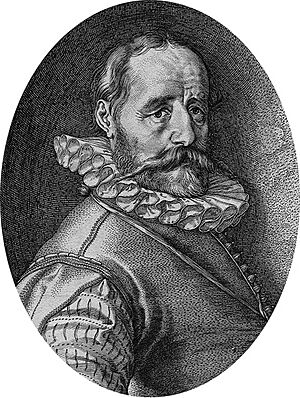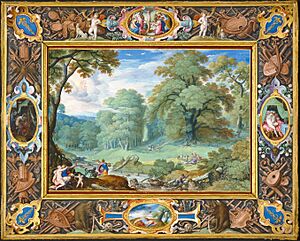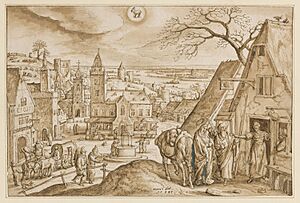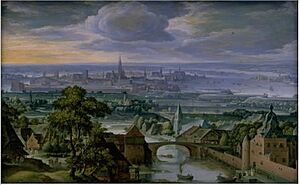Hans Bol facts for kids

Hans Bol (born December 16, 1534 – died November 20, 1593) was a talented artist from Flanders (part of what is now Belgium). He was a painter, a miniature painter (meaning he made very small, detailed paintings), a printmaker, and a draftsman (someone who makes drawings). He was famous for his beautiful landscapes, pictures that told stories from the Bible or myths, and everyday scenes. His art style was called Northern Mannerist, which meant it was often dramatic and showed figures in unusual poses.
Hans Bol had a successful career in Flanders. But during a difficult time called the Siege of Antwerp, he moved to the Dutch Republic (what is now the Netherlands). His landscape paintings greatly influenced the artists who came after him in the Netherlands. He also made many prints based on his own drawings and those of other famous Flemish artists like Pieter Brueghel the Elder. These prints helped spread popular art ideas throughout the Northern Netherlands.
Life of Hans Bol
Hans Bol was born in Mechelen, a city in Belgium, on December 16, 1534. He came from a respected family. He learned to paint from his two uncles, Jacob Bol I and Jan Bol, who were also painters in Mechelen. When he was 14, he became an apprentice to a local canvas painter. He learned a special way of painting on canvas using water-based paints.
From 1550 to 1552, Hans traveled in Germany, spending time in Heidelberg. He returned to Mechelen in 1560. On February 20, 1560, he became a master in the Mechelen Guild of Saint Luke. This was an important group for artists.
In 1572, Mechelen was taken over by the Spanish army. Hans Bol then moved to Antwerp, another city in Belgium. In 1574, he became a master in the Antwerp Guild of Saint Luke. The next year, in 1575, he became a "poorter" of Antwerp, which meant he was a full citizen of the city.
Ten years later, in 1584, Antwerp was also attacked by the Spanish. Hans Bol decided to leave Flanders, just like his brother Jacob had done earlier. He first went to Bergen-op-Zoom. In 1586, he traveled to Dordrecht and then through Delft to Amsterdam. He lived in Amsterdam until he died in 1593 from the plague.
Some of Hans Bol's students included his stepson Frans Boels, Joris Hoefnagel, and Jacob Savery. Other artists like Gillis van Coninxloo and David Vinckboons are also thought to have learned from him.
Hans Bol's Artworks
Hans Bol was a very skilled artist who worked in many different ways. He created oil paintings, watercolor paintings, and even illuminated manuscripts (beautifully decorated books). He also made many drawings and engravings (prints made from etched metal plates). His art included scenes from myths, stories with hidden meanings, Bible stories, and everyday life.
Bol is most remembered for his amazing landscape art. But he also played a big part in developing and spreading the art ideas of Pieter Bruegel the Elder. This included painting scenes of peasant life.
He began his career painting with watercolors and tempera paints on canvas. Not many of these early works have survived because the materials were not very long-lasting. These paintings were a cheaper way to decorate walls than expensive tapestries. Hans Bol became very successful in this type of painting, which was popular in Mechelen. So many people copied his designs that they were even sold under his name! Because of this, Bol started making very small, detailed works that were harder for others to copy. He became known for his tiny, colorful drawings on parchment (a type of animal skin used for writing and drawing).
Hans Bol is also famous for his many drawings and prints. His earliest known drawing, from 1557, shows a "Landscape with trees and a watermill." This drawing shows the influence of Pieter Bruegel the Elder. In this drawing, Bol moved away from the older Flemish style of "world landscapes," which showed imaginary mountain scenes with jagged rocks. Instead, he chose a more realistic style, drawing what he observed in nature. This drawing also suggests Bol knew the work of the "Master of the Small Landscapes." This unknown artist created drawings for print series in 1559 and 1661, showing real, beautiful country scenes around Antwerp. This realistic approach influenced many future Flemish landscape artists, including Bol.
Bol's drawings show how important he was in developing landscape art in the Low Countries. His landscapes often include people, sometimes from the Bible or just ordinary people. He mixed real details with imaginary parts. Hans Bol was influenced by Pieter Bruegel the Elder in his landscape art. Both artists also loved to show the seasons and months of the year. Bruegel had brought back this old tradition with his large series of paintings of the months in 1565.
After Bruegel, Hans Bol designed several series of prints showing the Four Seasons. A famous printer in Antwerp, Hieronymus Cock, had started this project with Bruegel. But when Bruegel died in 1569, he had only finished designs for Spring and Summer. The fact that Hieronymus Cock asked Bol to design Autumn and Winter shows how highly he was thought of by 1570. This meant the young Bol was seen as Bruegel's successor. The whole series was engraved (made into prints) by Pieter van der Heyden.
In the years that followed, Bol designed more series of the Four Seasons, showing activities typical of each season. A full set of designs for the Twelve Months is kept at the Museum Boijmans Van Beuningen. These designs were later engraved by Adriaen Collaert and published by Hans van Luyck in 1581. This helped his designs spread widely and influence many artists of his time.
Another set of drawings of the Twelve Months, from 1584-1585, was recently found. These drawings were used for 13 prints and were put together in a book. This book also contained drawings for the Emblemata Evangelica. This was a series of prints designed by Hans Bol, engraved by Adriaen Collaert, and published by Johannes Sadeler. Unlike the other series of months that showed human work for each month, these drawings combined scenes from the New Testament (like parables) with everyday scenes. The scenes of human work were moved to the background, and the religious scenes became the main focus. This was a new and interesting idea for art at that time. Some drawings even showed different parts of a story in one picture.
In 1582, Hans Bol and his workshop also decorated the Book of Hours for the Duke of Alençon. This was a special prayer book.
Hans Bol also made many drawings of cities, like "A view of Antwerp harbor." Towards the end of his life, he created several drawings of wooded landscapes.
Images for kids







